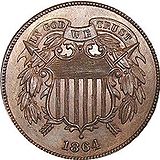
Coinage Act (1864)
Encyclopedia
The Coinage Act of 1864, a United States federal law, changed the composition of the one-cent coin
and authorized the minting of the two-cent coin
. The Director of the United States Mint
was directed to develop the designs for these coins for final approval of the Secretary of the Treasury.
 As a result of this law, the phrase "In God We Trust
As a result of this law, the phrase "In God We Trust
" first appeared, on the 1864 two-cent coin.
Congress
passed the Act on April 22, 1864.
Another Act of Congress, passed on March 3, 1865, allowed the Mint Director, with the Secretary's approval, to place the phrase on all gold
and silver coin
s that "shall admit the inscription thereon."
In 1956 "In God We Trust
" replaced "E Pluribus Unum
" as the national motto. All currency was printed and minted with the new motto.
Cent (United States coin)
The United States one-cent coin, commonly known as a penny, is a unit of currency equaling one one-hundredth of a United States dollar. The cent's symbol is ¢. Its obverse has featured the profile of President Abraham Lincoln since 1909, the centennial of his birth. From 1959 to 2008, the reverse...
and authorized the minting of the two-cent coin
Two-cent piece (United States coin)
The two-cent coin was produced in the United States from 1864–1873 with decreasing mintages throughout that time. In terms of consumer price indexes, the 1864 coin would be comparable to $ in today's money....
. The Director of the United States Mint
Director of the United States Mint
The Director of the United States Mint is the head of the United States Mint. The position is currently vacant following the resignation of Edmund C. Moy in January 2011....
was directed to develop the designs for these coins for final approval of the Secretary of the Treasury.

In God We Trust
"In God We Trust" was adopted as the official motto of the United States in 1956. It is also the motto of the U.S. state of Florida. The Legality of this motto has been questioned because of the United States Constitution forbidding the government to make any law respecting the establishment of a...
" first appeared, on the 1864 two-cent coin.
Congress
United States Congress
The United States Congress is the bicameral legislature of the federal government of the United States, consisting of the Senate and the House of Representatives. The Congress meets in the United States Capitol in Washington, D.C....
passed the Act on April 22, 1864.
Another Act of Congress, passed on March 3, 1865, allowed the Mint Director, with the Secretary's approval, to place the phrase on all gold
Gold coin
A gold coin is a coin made mostly or entirely of gold. Gold has been used for coins practically since the invention of coinage, originally because of gold's intrinsic value...
and silver coin
Silver coin
Silver coins are possibly the oldest mass produced form of coinage. Silver has been used as a coinage metal since the times of the Greeks. Their silver drachmas were popular trade coins....
s that "shall admit the inscription thereon."
In 1956 "In God We Trust
In God We Trust
"In God We Trust" was adopted as the official motto of the United States in 1956. It is also the motto of the U.S. state of Florida. The Legality of this motto has been questioned because of the United States Constitution forbidding the government to make any law respecting the establishment of a...
" replaced "E Pluribus Unum
E pluribus unum
E pluribus unum , Latin for "Out of many, one", is a phrase on the Seal of the United States, along with Annuit cœptis and Novus ordo seclorum, and adopted by an Act of Congress in 1782...
" as the national motto. All currency was printed and minted with the new motto.
See also
- Coinage Act of 1792
- Coinage Act of 1834Coinage Act of 1834The Coinage Act of 1834 was passed by the United States Congress on June 27, 1834. It raised the silver-to-gold weight ratio from its 1792 level of 15:1 to 16:1 thus setting the mint price for silver at a level below its international market price...
- Coinage Act of 1849
- Coinage Act of 1857Coinage Act of 1857The Coinage Act of 1857 was an act of the United States Congress which forbade the use of foreign coins as legal tender, repealing all acts "authorizing the currency of foreign gold or silver coins". Specific coins would be exchanged at the Treasury and recoined...
- Coinage Act of 1873
- Coinage Act of 1965Coinage Act of 1965The Coinage Act of 1965, , eliminated silver from the circulating dimes and quarter dollars of the United States, and diminished the silver content of the half dollar from 90% to 40%...

